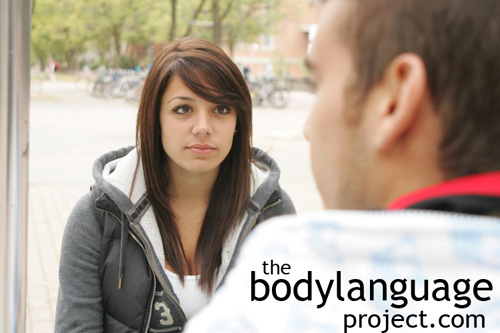Body Language of Relaxed Face
Synonym(s): Calm Face.
Description: A face that is not compressed, where muscles are not flexed, the eyebrows are not clenched together, the forehead is smooth rather than wrinkled, the eyes are open and not tensed and the lips are full.
In One Sentence: A relaxed face shows high comfort and lack of negative thoughts.
How To Use it: Use a relaxed face when you want to show others that you are in control over your life and the results in it. In business, having a relaxed face should be the default condition. Having a relaxed faces tells others that you can be counted upon for rational decisions in resolving problems. While an angry face can be used to show others that they should take you seriously, a relaxed face shows others that you are in control of your emotions. This is viewed as a positive attribute. When facing high stress, a relaxed face is most potent to onlookers and produces the highest amount of respect and admiration. A relaxed face in these situations signals leadership.
Context: General.
Verbal Translation: “I’m free of stress, I’m comfortable and hold no negative thoughts. As a result, there is no tension in my face, none of its muscles are flexed.”
Variant: See Tense Face for the opposite cue. Also see Eyebrows Knit or Oblique Eyebrows Of Grief, Compressed Lips.
Cue In Action: Sitting at home reading a book put him at ease. His face was relaxed and the furrow between his eyes finally faded along with the stress of the day.
Meaning and/or Motivation: A relaxed face is one that shows comfort and comfort is a cue that delineates honesty, and that the body is free of concern or negative thoughts.
Comfortable people will hold their bodies loose rather than rigid, and their body will move with fluidity. They will gesture with their speech instead of freezing instantly or awkwardly, called “flash frozen.” Comfortable people mirror others around them instead of avoiding synchrony. Their breath rate will be similar and they will adopt like postures instead of showing differences.
A relaxed face is the normal resting face or the “default face” for people. When no negative stimuli are present, it’s the face, free of wrinkle, or contortion that takes over. Conversely, when bad thoughts, stress, anxiety presents itself, the face tenses up and muscles around the forehead, between the eyes and mouth (lip pursing) begin to flex and pulls the face in all sorts of different directions.
Cue Cluster: The eyes are big, the body may splay open, the arms and legs will uncross, smiling occurs readily, people will loosen clothing or remove them to make themselves more comfortable, they will speak easily and casually, a leg can be tucked under and sat on, the body might sag to one side or lay out flat exposing the ventral side, breathing is steady.
Body Language Category: Confused, Comfort body language, Open facial gestures, Relaxed body language.
Resources:
Browning, E. ; Huynh, C. ; Peissig, J. Show Me Your Poker Face: Are Poker Players Better at Recognizing Emotional Expressions? Journal of Vision. 2013. 13(9): 599-599.
Carvajal, Fernando ; Rubio, Sandra ; Serrano, Juan ; Ríos-Lago, Marcos ; Alvarez-Linera, Juan ; Pacheco, Lara ; Martín, Pilar. Is a neutral expression also a neutral stimulus? A study with functional magnetic resonance. Experimental Brain Research, 2013. 228(4): 467-479.
Ekas, Naomi V. ; Haltigan, John D. ; Messinger, Daniel S. The Dynamic Still-Face Effect: Do Infants Decrease Bidding over Time when Parents Are Not Responsive?
Developmental Psychology. 2013. 49(6): 1027-1035.
Kraft, Tara L ; Pressman, Sarah D. Grin and Bear It. Psychological Science. 2012. 23(11): 1372-1378.
Heisel, Marnin ; Mongrain, Myriam. Facial Expressions and Ambivalence: Looking for Conflict in All the Right Faces. Journal of Nonverbal Behavior. 2004. 28(1): 35-52.
Giuseppe Blasi; Ahmad R. Hariri; Guilna Alce; Paolo Taurisano; Fabio Sambataro; Saumitra Das; Alessandro Bertolino; Daniel R. Weinberger and Venkata S. Mattay. Preferential Amygdala Reactivity to the Negative Assessment of Neutral Faces. 2009. 6(9): 847-853.
King, Laura A. Ambivalence over emotional expression and reading emotions in situations and faces. Journal of Personality and Social Psychology. 1998 74(3): 753(10)
Matsumoto, David ; Hwang, Hyisung C. Desteno, David (editor). Judgments of Subtle Facial Expressions of Emotion. Emotion. 2014. 14(2): 349-357.
Mignault, Alain and Chaudhuri, Avi. The Many Faces of a Neutral Face: Head Tilt and Perception of Dominance and Emotion. Journal of Nonverbal Behavior. 2003 27(2): 111-132.
Navarro, Joe. 2008. What Every BODY is Saying: An Ex-FBI Agent’s Guide to Speed-Reading People. William Morrow Paperbacks.
Shah, Rebecca ; Lewis, Michael. Locating the neutral expression in the facial-emotion space. Visual Cognition. 2003. 10(5): 549-566.
Sturman, Edward D. Invluntary Subordination and Its Relation to Personality, Mood,
and Submissive Behavior. Psychological Assessment. 2011. 23(1): 262-276 DOI: 10.1037/a0021499
http://bodylanguageproject.com/articles/nonverbal-submission-men-women-depression-critical-examination-use-disuse-submission/
Weisfeld, Glenn E. and Jody M. Beresford. Erectness of Posture as an Indicator of Dominance or Success in Humans. Motivation and Emotion. 1982. 6(2): 113-130.
http://bodylanguageproject.com/articles/body-language-cues-dominance-submission-children/
Woud, Marcella L. ; Becker, Eni S. ; Lange, Wolf – Gero ; Rinck, Mike. Effects of approach-avoidance training on implicit and explicit evaluations of neutral, angry, and smiling face stimuli.(Relationships & Communications). Psychological Reports. 2013. 113(1): 1211(18).
Vanderhasselt, Marie – Anne ; Kühn, Simone ; De Raedt, Rudi. Put on your poker face’: neural systems supporting the anticipation for expressive suppression and cognitive reappraisal. Social Cognitive and Affective Neuroscience. 2013 8(8): 903-910.
Wolf K, Mass R, Ingenbleek T, Kiefer F, Naber D et al. (2005) The facial pattern of disgust, appetence, excited joy and relaxed joy: an improved facial EMG study. Scand J Psychol 46: 403-409. doi: 10.1111/j.1467-9450.2005.00471.x. PubMed: 16179022.
Zeinstra, Gertrude G.; M.A. Koelen; D. Colindres ; F.J. Kok; C de Graaf. Facial Expressions in School-Aged Children are a Good Indicator of ‘Dislikes’, but not of ‘Likes.’ Food Quality and Preference. 2009. 20: 620-624.
http://bodylanguageproject.com/articles/read-kids-dislike-food-facial-expressions-accurate-detecting-dislike-not-like-children/

